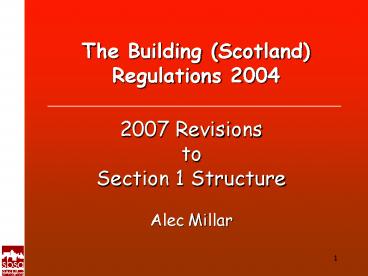The Building Scotland Regulations 2004 - PowerPoint PPT Presentation
1 / 50
Title:
The Building Scotland Regulations 2004
Description:
Design additional measures. 14. 1.2.2 Domestic Risk Groups. Houses max 4 storeys ... National House Building Council. UK Timber Frame Association. Brick ... – PowerPoint PPT presentation
Number of Views:61
Avg rating:3.0/5.0
Title: The Building Scotland Regulations 2004
1
The Building (Scotland) Regulations 2004
- 2007 Revisions
- to
- Section 1 Structure
- Alec Millar
2
Little LARGE
- Single family dwelling
- PetronasTowers
- 452 m high
- 88 Floors
3
Coverage
- Standard 1.1 Structure
- Standard 1.2 Disproportionate Collapse
- Domestic/Non-domestic variations
- Small Buildings Structural Guidance
4
1.0 Introduction
- Background
- Latest changes
- Alternative approaches
- Eurocodes alongside BSs 2007-2010
5
Non-domestic relevant legislation
- Safety of Sports Grounds Act 1975
- Fire Safety Safety of Places of Sport Act 1987
- Guide to Safety at Sports Grounds
- Civic Government (Scotland) Act 1982
- Institution of Structural Engineers publications
6
Revised Standard 1.1 Structure
- Every building must be designed and
- constructed in such a way..,taking into account
the nature of the ground, will not lead to - (a) the collapse .of the building
- (b) deformations which would make the building
unfit for its intended use, unsafe , or cause
damage to other parts of the building... - (c) Impairment of the stability of any part of
another building
7
Nature of the ground
8
Stability of another building
- Ground water
- lowering
- Increased foundation loads
New large building
Existing small building
W
W
Pressure bulb from W
Pressure bulb from W
Additional settlement
Lowered water table
9
Standard 1.2Disproportionate Collapse
- Every building must be designed and
- constructed in such a way that in the
- event of damage occurring to any part
- of the structure of the building the
- extent of any resultant collapse will
- not be disproportionate to the original
- cause.
10
What is Disproportionate Collapse ?
11
What is Accidental Overloading ?
12
New Disproportionate Collapse Guidance
- Covers all buildings
- Risk based methodology
- Based on Structural Eurocode 1 Part 1-7
Accidental Actions - Updated British Standards
13
Risk Based Approach
- Determine Building risk group
- Assess additional measures
- Design additional measures
14
1.2.2 Domestic Risk Groups
- Houses max 4 storeys
- Garages/conservatories
- 2A Houses 5
storeys - Flats maisonettes max 4 storeys
- 2B Flats maisonettes 5- 15 storeys
- Buildings exceeding above limits
15
1.2.2 Non-domestic Risk Groups
- Agricultural buildings
- 2A Hotels/ Offices max 4 storeys
- Shops max 3
storeys - Educational buildings max 1 storey
- 2B Hotels/ Offices/Shops max 15 storeys
- Hospitals max 3
storeys - Buildings exceeding above limits
- Grandstands gt 5000 spectators.
16
1.2.3 Assess Additional Measures
- RG1 No additional measures
- RG2A Horizontal Ties
- RG2B Horizontal Vertical Ties
- or
- Max collapse area 15/ 70 m2
- RG3 Systematic risk assessment
17
Risk Group 2A Horizontal Ties
18
Risk Group 2B Vertical Horizontal Ties
19
Risk Group 2B Limits of Collapse
- Plan
Elevation
Max collapse area Lesser of 15 or 70m2 not
beyond adjacent storeys
20
1.2.5 Other sources of guidance
- National House Building Council
- UK Timber Frame Association
- Brick Development Association
- Steel Construction Institute
21
Questions on Section 1
Cheryl Brolly 01506 600444 Alec Millar 01506
600426
cheryl.brolly_at_sbsa.gsi.gov.uk
alec.millar_at_sbsa.gsi.gov.uk
22
Small Buildings Guide
- Last revised June 1994
- Standards outdated
- Outdated construction
- Not accessible
- Prescriptive wording
23
Small Buildings Structural Guidance (SBSG)-
General
- Current BSs and BS ENs
- Rewritten as Guidance
- Within Domestic Technical Handbook
- Houses only
- Key factors
- Referral to specialists
24
SBSG Latest Technical Changes
- Extra Geotechnical Foundation guidance
- Ground level differences
- Wall Ties
- New Wind and Snow Loads
- Timber Frame Walls
- Updated Timber Span Tables
25
New Snow Wind Maps
26
Annex 1.A General
- Introduction
- Separate annexes
- Timber frame walls
- Overall scope
- 3 storey masonry
- 2 storey timber frame
- Overall flow chart
- Explanation of terms
27
Annex 1.B Stability
- Expanded recommendations
- Robust 3D box structure
- Roof bracing
28
Annex 1.C Foundations
- Strip foundations Stepped
foundations
29
Extra Foundations Guidance
- Eccentric Building
Extensions
30
Annex 1.D Masonry Wall heights
31
Annex 1.D Masonry Walls
- Wall ties for wider cavities
- Stainless steel or non-ferrous wall ties
- Masonry strengths and diagrams
- Ground level differences
32
Single storey, single leaf buildings
- Restricted to
- domestic extensions and
- within curtilage of dwelling
- More detailed diagrams on openings
- and piers and limitations
33
Annex 1.E Timber Frame Walls
- Target users
- Limited to 2 storey houses
- 2.7m max panel height
- Masonry outer leaf
- Similar to Annex 1.D layout
34
Timber member sizing
35
Wall sheathing
36
Example Site building data
37
Example Altitude/distance ß
38
Example- Racking resistance
39
Example- Internal walls
40
Example- Loadings
41
Example -Wall Studs
42
Example- Cripple Studs Lintels
43
Construction materials
44
Fabrication/composite action
45
Openings, notching drilling
46
Differential Movement
- Key factors
- Vertical movement
- Timber masonry
- Platform frame construction
47
Annex 1.F Timber Span Tables
- Grade C16 C24
- Notching drilling
- Dead load guidance
- Updating of flat roof floor joist tables
- Limited cut roofs
48
Miscellaneous
49
Summary
- Standard 1.1 Structure
- - Nature of ground
- Stability of another building
- Standard 1.2 Disproportionate Collapse
- Domestic Non-domestic differences
- Small Buildings Structural Guidance
50
Questions on SBSG
Cheryl Brolly 01506 600444 Alec Millar 01506
600426
cheryl.brolly_at_sbsa.gsi.gov.uk
alec.millar_at_sbsa.gsi.gov.uk































